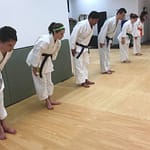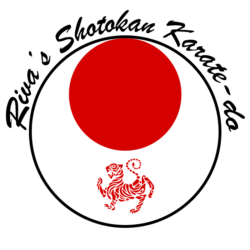
Master Gichin Funakoshi, the founder of Shotokan Karate, said, “Karate begins and ends with courtesy,” and this level of etiquette helps form the foundation of Shotokan Karate. Etiquette enables karateka to train with discipline and respect – respect for the dojo, the sensei and sempai, and for other karateka. A karateka who understands the principles of etiquette and practices the same will be a credit not only to themselves but also to his/her instructor and fellow karateka.
Good etiquette makes for good karate. It should play an important part in karate training. It is pure common courtesy and should not be interpreted or considered an act of subservience. Mutual respect is important in karate and applying the principles of etiquette inside and outside the dojo helps engender mutual respect.
In a dojo, etiquette allows for a high-trust environment for karateka that supports growth outside one’s comfort zone. Students are encouraged to try new things in the dojo because they know that their dojo brothers and sisters will be supportive of them and keep them safe. Asking if the behavior you are about to exhibit shows respect to fellow students, the instructor, and the dojo your answer will automatically guide you to the correct dojo behavior and etiquette.
Studying karate is much more than learning to perfect a variety of techniques. It requires an understanding of the cultural and historical background which has given rise to the conventional code of conduct. The importance of culture, tradition, and philosophy in karate are readily expressed by the conventional code of conduct and etiquette which emanated from the ancient traditions of Okinawa and Japan. An understanding of that history must inform karateka training.
Within the framework of overall Shotokan Karate etiquette, each dojo is different. Karateka must conform to the etiquette examples set by their sensei and the rules/dojo kun of their dojo. For example, at RSK sensei Riva welcomes questions and dialogue from her students, of which I take full advantage. If I was to train with another sensei, I would need to follow the rules of that dojo, which may not welcome questions and dialogue. It is best to error on the side of being overly courteous when training at another dojo without standing out, as that in itself can be interpreted as rudeness.
Though etiquette varies from dojo to dojo, there are certain etiquette principles that can be found in many Shotokan Karate dojos. These include:
- Arrive to class 10-15 minutes early
- Prepare to train through good hygiene (fingernails and toenails clean and trimmed, etc.) and a clean gi
- Prepare the dojo for training, including cleaning the training area
- Bow entering and leaving the training area
- Line-up swiftly and quietly
- The moment class begins focus on karate and not areas of life outside the dojo
- Practice hard and be spirited
- Do not be disruptive or disrespectful to instructors and senior karateka, but also do not hesitate to ask senior students and instructors for help before or after class.
- Thank the sensei, sempai, and senior karateka at the end of class
Etiquette is like other aspects in martial arts. By exercising discipline, patience, and perseverance, a karateka can continue to improve as a martial artist, with the added benefit of taking the etiquette principles and examples from the dojo and applying them to aspects of a karateka’s life outside the dojo. A good principle is to have behavior, both inside and outside the karate dojo, be guided by respect to others.
As Master Gichin Funakoshi also said, “Do not think that karate training occurs only in the dojo.”
